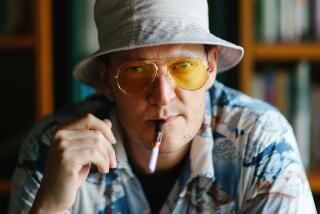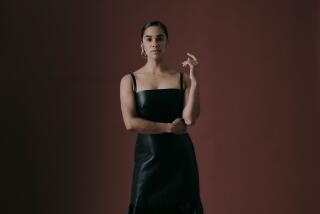Taking flight with Sinatra
NEW YORK â When Frank Sinatra fans play his music, classic songs like âSummer Wind,â âFly Me to the Moonâ and âOne for My Babyâ will likely trigger strong emotions and memories. But when Twyla Tharp sifts through his catalog, it conjures up an entire world.
Who was she when she first heard these songs, compared with the woman she is today? Why do they remind her of so many couples sheâs known? And what is the essence of Olâ Blue Eyesâ music beyond the thrill of an unforgettable vocal?
Tharp, one of the dance worldâs most respected choreographers and directors, set out to answer these questions in her newest musical, âCome Fly With Me,â based on Sinatraâs songs, which began previews this week at Atlantaâs Alliance Theatre. It has become a very personal pursuit for her, even though she is dealing with a musical library that is intimately familiar to millions.
âThereâs a lot of history for me here,â she said, minutes after watching a final rehearsal of the show in New York. âI wanted to get at some deeper meaning in this music, to open a much bigger world.â
The new two-act musical tells the story in dance of four couples who meet and fall in and out of love in one night. As their tales unfold, tapes of vintage Sinatra vocals are accompanied by a live 17-piece big band playing original orchestrations by Nelson Riddle, Billy May, Quincy Jones and others.
Although Sinatraâs songs were typically sung from a manâs point of view, Tharp gives equal voice to both sexes in her storytelling. In the case of one couple, a man meets a woman and they have a torrid affair. But soon she feels stifled by him and falls into the arms of other men, flaunting her independence. Then she returns, and they plunge into a stormy, unsettled relationship. At the end, nothing is resolved.
âIn this version, the women have their own reality,â said Tharp, toying with a platter of Greek food in a Manhattan restaurant. âThey instigate a lot of the action. Thereâs a female vocalist who sings several numbers with the band, to offer a womanâs perspective, and the men have to deal with it. Itâs no longer about things happening their way.â
Audiences have powerful memories of Sinatra songs, she added, âbut theyâll also have memories of relationships in their lives. Relationships that failed, relationships that worked, relationships that evolved into being just friends, and relationships where you donât speak to the person anymore. By the end it should feel like the scrapbook of your love life.â
Tharp has used Sinatraâs music as a soundtrack in three previous ballets, but the new musical is easily her most ambitious effort yet. It follows on the heels of two shows that also choreographed a musical narrative to the songs of a pop music giant: âMovinâ Out,â her 2001 musical set to the songs of Billy Joel, won a Tony Award, played 1,303 performances on Broadway and toured for three years. âThe Times They Are AâChangin,â a 2006 show featuring the songs of Bob Dylan, opened to blistering reviews and closed after four weeks.
Ever since she burst onto the scene in 1966, Tharp has been a bold iconoclast. She has steeped herself in classic and modern genres, blending them unexpectedly and then moving onto something new. Always unpredictable, sheâs made a name for herself by combining the kinetic energies of dance with surging pop soundtracks.
Producers and other backers are betting that âCome Fly With Meâ will strike a chord with graying baby boomers plus a hip, younger audience, and early indications are that Tharp has cooked up a potent mix of dance, music and visual imagery. During a recent rehearsal, her troupe of 20 dancers twirled, spun, leaped and kicked their way through an eye-popping performance as Sinatraâs vocals filled the room. The preview won hearty applause from an audience of VIPs, including Mikhail Baryshnikov, who has performed Tharpâs 1984 âSinatra Suite.â Her two other Sinatra shows included âOnce More Frankâ in 1976 and âNine Sinatra Songsâ in 1982. They are among her most widely performed dances.
The new show is still being tweaked for a Wednesday opening. But some who have seen âCome Fly With Meâ are already smitten.
âI knew right away that she [Tharp] had captured the essence of my fatherâs music in dance,â said Nancy Sinatra, who flew to New York to catch a run-through. âYou see the personalities of the dancers play out as their stories are told. People will really identify with these stories.â
The new show couldnât have gelled without the cooperation of the late singerâs family. Tharp, musical director Sam Lutfiyya and others combed through the singerâs catalog of more than 1,500 songs, searching not only for the right numbers but also the right vocal takes. Although the Sinatra estate does not control rights to the songs themselves, it holds the rights to his vocals and orchestrations.
Much of the show is a homage, but Tharp also took creative liberties, adding jazz vocalist Dee Daniels to the band for a womanâs take on songs like âMaking Whoopeeâ and âTeach Me Tonight.â Tharp felt comfortable doing so after receiving positive feedback from Sinatra himself on her previous ballets using his music: âHe was a fan,â she said. âHe came to these shows and wanted to see them done. He was supportive and very proud of it.â
Although Tharp initially had trouble justifying yet another Sinatra show, the challenge of uncovering deeper meanings in his songs proved irresistible. Indeed, she has recast many of the tunes with a new story line.
âOne for My Baby,â for example, is no longer the tale of a boozy, existential loner complaining about the women who have left him. Two dancers play out the story of an exhausted, feuding couple at the end of a long night; theyâre unable to live with or without each other, but they still have a friendship that endures.
With the opening just days away, Tharp politely waved off any questions about where the show might go next, and when. But she did concede that others may soon be asking repeatedly: Is âCome Fly With Meâ headed for Broadway? What are the chances of a future national tour?
âI donât think there are any rules,â she said. âShowbiz is not that orderly. But the answer is simple: First, the audience has to love it.â
--
More to Read
The biggest entertainment stories
Get our big stories about Hollywood, film, television, music, arts, culture and more right in your inbox as soon as they publish.
You may occasionally receive promotional content from the Los Angeles Times.










